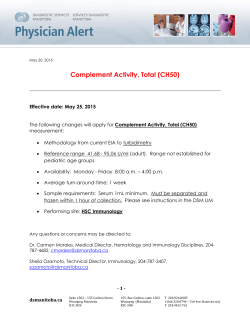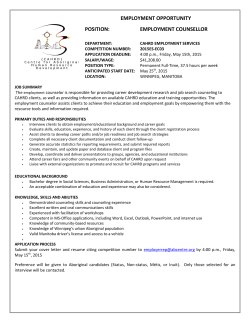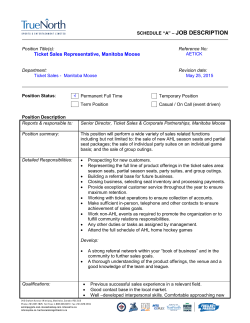
This Report - Lifesaving Society Manitoba
Manitoba 2015 Edition REPORT Prepared for the Lifesaving Society Canada by the Drowning Prevention Research Centre Canadian Totals 1990 - 2012 683 685 632 622 601 632 617 566 551 503 472 1990 1991 1992 1993 1994 1995 1996 1997 1998 492 448 457 450 508 480 494 470 495 483 450 433 1999 2000 2001 2002 2003 2004 2005 2006 2007 2008 2009 2010 2011 2012 *National total unknown due to unavailability of 2011 Alberta data. After a surge in drowning deaths in Manitoba in 2011 (40), 2012 saw a 50% decrease in the number of water-related fatalities (20) and a return to a more typical death rate of 1.6 per 100,000 population. Manitoba Water-Related Fatalities and Death Rates 2003-2012 Despite this encouraging reduction, looking at the most current five years (2008-2012) of data as a whole, the average water-related fatality rate increased by 28% over the previous five year period. The average drowning rate for 2008-2012 was 2.3 per 100,000 population (up from 1.8). The increase can be attributed partially to the 2011 drowning spike. A total of 139 unintentional water-related fatalities occurred in Manitoba between 2008 and 2012. Death Rate per 100,000 per Year Number of Fatalities per Year 40 30 27 Preliminary interim data 25 22 22 For drownings since 2012, only preliminary, interim data from media and internet reports are available. In Manitoba, these numbers indicate that at least 12 drownings occurred in 2013 and at least 15 in 2014. 19 19 20 3.2 2.5 1.9 2.1 1.6 1.4 1.6 1.7 1.6 2.2 1.8 20 1.4 1.6 2003 2004 2005 2006 2007 2008 2009 2010 2011 2012 WHO is drowning? Pools 4% Bathtubs 4% The vast majority of Manitoba drowning victims are men (8 out of 10). Between 2008 and 2012, the average water-related fatality rate for men was 3.8 per 100,000 population compared to 0.7 for women. In 2012, the proportion of male victims was even greater than 8 out of 10; 85% of water-related fatalities occurred among males in this most recent year. By age, the highest drowning rates in Manitoba continue to be found among young adults 20-24 years of age (4.6 per 100,000). Teenagers 15-19 years of age and young adults 30-34 years of age also had high drowning rates in the 2008-2012 period (3.0 and 3.3 respectively). Adults over the age of 65 are also an at-risk population in Manitoba. The highest water-related fatality rates in this group were found among 65-69-year-olds (3.3) and 80-84-year-olds (3.1). Despite a long term trend towards decreased drowning death rates among children under 5 years in Canada, rates remain relatively high among this age group in Manitoba. Between 2008 and 2012, the average water-related fatality rate for children under 5 was 2.1 per 100,000. This rate is higher than in most other provinces. The national drowning rate in this age group averages about 1.1 per 100,000 in recent years. Water-Related Death Rate By Age, 2008-2012 4.6 3.0 2.2 2.1 3.3 3.0 WHERE are they drowning? Natural bodies of water continue to account for the largest proportion of drownings in Manitoba in 2008-2012 (75%). Lakes claimed the greatest number of lives (40%) followed by rivers and streams (35%). In 2012, all victims drowned in a natural body of water; 12 in a lake and 8 in a river or stream. Drownings in lifeguard supervised settings continue to be rare: in 2008-2012 only 1% of drownings in Manitoba occurred under lifeguard supervision. 3.1 1.3 1.3 1.6 1.9 1.5 59 10 -14 15 -19 20 -2 4 25 -2 9 30 -3 4 35 -3 9 40 -4 4 45 -4 9 50 -5 4 55 -5 9 60 -6 4 65 -6 9 70 -7 4 75 -7 9 80 -8 4 85 + 1.0 04 Ditches 10% 2.3 1.8 1.8 1.6 Lakes 40% Rivers 35% Drownings in man-made settings such as bathtubs (4%) and pools (4%) continue to be few in Manitoba. Water-related fatalities were more likely to occur in a ditch (10%) than in a bathtub or pool. The proportion of ditch drownings in Manitoba is unusually large; the majority of these fatalities were the result of motor vehicle incidents among young adults between the ages of 20 and 39. Average Death Rate per 100,000 per Year 3.3 Other 7% Death rates should be interpreted with caution due to small sample size In 2008-2012, drownings more commonly occurred in rural (74%) versus urban (26%) settings. This proportion is different from most other provinces where the majority of drownings occur in urban environments. The greatest number of drownings in 2012 occurred in the Northern region (45%) followed by Winnipeg (20%). WHEN are they drowning? Water-Related Fatalities by Time of Year By time of year, the warmer months still account for the majority of drownings in Manitoba. Over two thirds (71%) of water-related fatalities in the 2008-2012 period occurred in May through September. The highest number of drownings occurred in July and August (40%). In 2012, 8 drownings occurred in July alone, which accounted for 40% of the total water-related fatalities in Manitoba that year. May Jan 1% Feb 1% Mar 1% 10% Apr 12% 9% Jun 22% Jul 18% Aug 11% Sep 4% Oct 5% Nov Over half (53%) of the 2008-2012 drownings happened on the weekend (Friday, Saturday or Sunday). In 2012, one third of all drownings in Manitoba occurred on a Saturday. WHAT were they doing? By purpose of activity, recreational activities continue to account for the majority of drownings in Manitoba. Over half (54%) of individuals who drowned between 2008 and 2012 were engaged in a recreational activity at the time. Among these, the most common primary recreational activity was swimming (21%), followed closely by walking, running or playing near water (20%). In 2012 however, none of the recreational drownings were related to walking, running or playing near water. The most common primary recreational activity in 2012 was powerboating (23%). Daily living incidents continue to account for a high proportion of drownings in Manitoba (27%). Almost two thirds (61%) of these deaths 4% Dec occurred during motor vehicle travel. Motor vehicle incidents most commonly involved a river or a ditch. The next highest proportion of daily living drownings in Manitoba occurred during travel on foot (13%). These victims were most likely to fall into a lake or a river while walking. By type of activity, the greatest proportion of Manitoba incidents in 20082012 occurred while boating (25%). The majority of boating incidents occurred while canoeing (43%) or during powerboat use (37%). These numbers differ from national trends. In most other provinces powerboat incidents make up the largest proportion of boating deaths by a large margin, and canoeing fatalities a lesser amount (21%). In cases where the information was available, 92% of victims were not wearing a lifejacket when the boating incident occurred. In most of the watercraft related fatalities (80%) the victim had consumed alcohol. After boating, the second most common type of activity was land, ice or air transportation (24%). Water-Related Fatalities by Most Common Recreational Activity Swimming 21% Walking/Running/ Playing Near Water 20% Power Boating 17% Canoeing Fishing 15% 11% Risk factors In summary The major risk factors contributing to drowning incidents in Manitoba continue to be consistent with those the Lifesaving Society has identified for the national population in the past, however alcohol consumption appears to be even more of a factor in Manitoba than in other provinces. Water-related fatality rates in Manitoba are highest among men and people 20-24 years old. Drownings are most likely to occur during the summer, on weekends, and in natural bodies of water such as lakes and rivers. Boating Swimming The highest proportion of incidents occurs during a recreational activity, most commonly swimming or recreating near the water. Not wearing a PFD (92% of cases where known) Alone or with other minors only (50%) Despite the dip in Manitoba drownings in 2012, the increased death rate demonstrated by the five-year average reinforces the need for continued strong drowning prevention efforts. Capsizing (40%) Victim was a non-swimmer (25%) Falling overboard (20%) Alcohol consumption (80%) Alcohol consumption (38%) Boating in twilight or darkness (29%) • collects the data needed to profile victims of aquatic incidents, including the circumstances and contributing factors under which these incidents occurred. <5 Alone near water (75%) 35-64 Alcohol consumption (72%) Supervision absent or distracted (88%) Alone (46%) 15-34 Alcohol consumption (71%) Complete data from 2008-2012 The drowning research process involves data collection, research tabulation, and analysis. Water-related death data is extracted from the office of the Chief Medical Examiner of Manitoba. The scope of this research: Age 5-14 With other minors only (60%) Research methodology • includes all deaths in Manitoba resulting from incidents “in, on or near” water; “near-water” incidents were included if the incident was closely related to waterbased recreational, vocational or daily living activity, or if the presence of water appeared to be an attraction contributing to the incident. • includes only preventable (unintentional) deaths, not deaths due to natural causes, suicide, or homicide. Not wearing a PFD when relevant (67%) Interim data 65+ Alcohol consumption (55%) Complete final data on more recent drownings and other water-related deaths are not yet available from the Office of the Chief Medical Examiner. The interim, preliminary data are derived from media releases, media clippings, news reports and internet searches. Alone (65%) Alone (36%) Acknowledgments We gratefully acknowledge the support, co-operation and efforts of: After dark (35%) • The Office of the Chief Medical Examiner of Manitoba which permitted and facilitated confidential access to coroners’ reports on preventable water-related deaths. Not wearing a PFD when relevant (65%) • The volunteers who contributed their time and energy including data extraction on preventable water-related deaths from coroners’ files. • Tessa Clemens who was primary author and data analyst for this report and Lucie Simoes who provided data input and verification. Contact us Lifesaving Society Manitoba Tel: 204-956-2124 Email: aquatics@lifesaving.mb.ca www.lifesaving.mb.ca Drowning Prevention Research Centre Canada The Drowning Prevention Research Centre is the lead agency for drowning and water-incident research in Canada. The Centre conducts research into fatal and non-fatal drowning, significant aquatic injury and rescue interventions. Contact Barbara Byers, Research Director, Email: experts@drowningresearch.ca, Telephone: 416-490-8844. The Lifesaving Society The Lifesaving Society – Canada’s lifeguarding experts – works to prevent drowning and water-related injury through its training programs, Water Smart® public education, aquatic safety management, drowning research and lifesaving sport. Annually, over 1,000,000 Canadians participate in the Society’s swimming, lifesaving, lifeguard and leadership training programs. The Society sets the standard for aquatic safety in Canada and certifies Canada’s National Lifeguards.
© Copyright 2025









